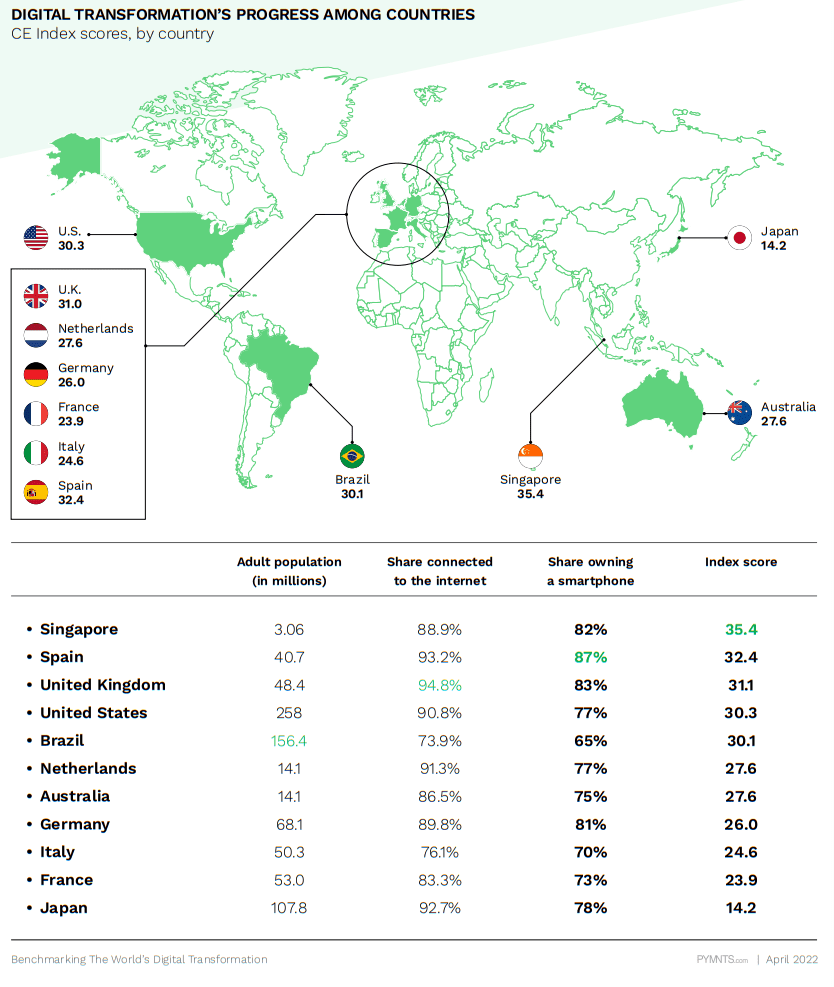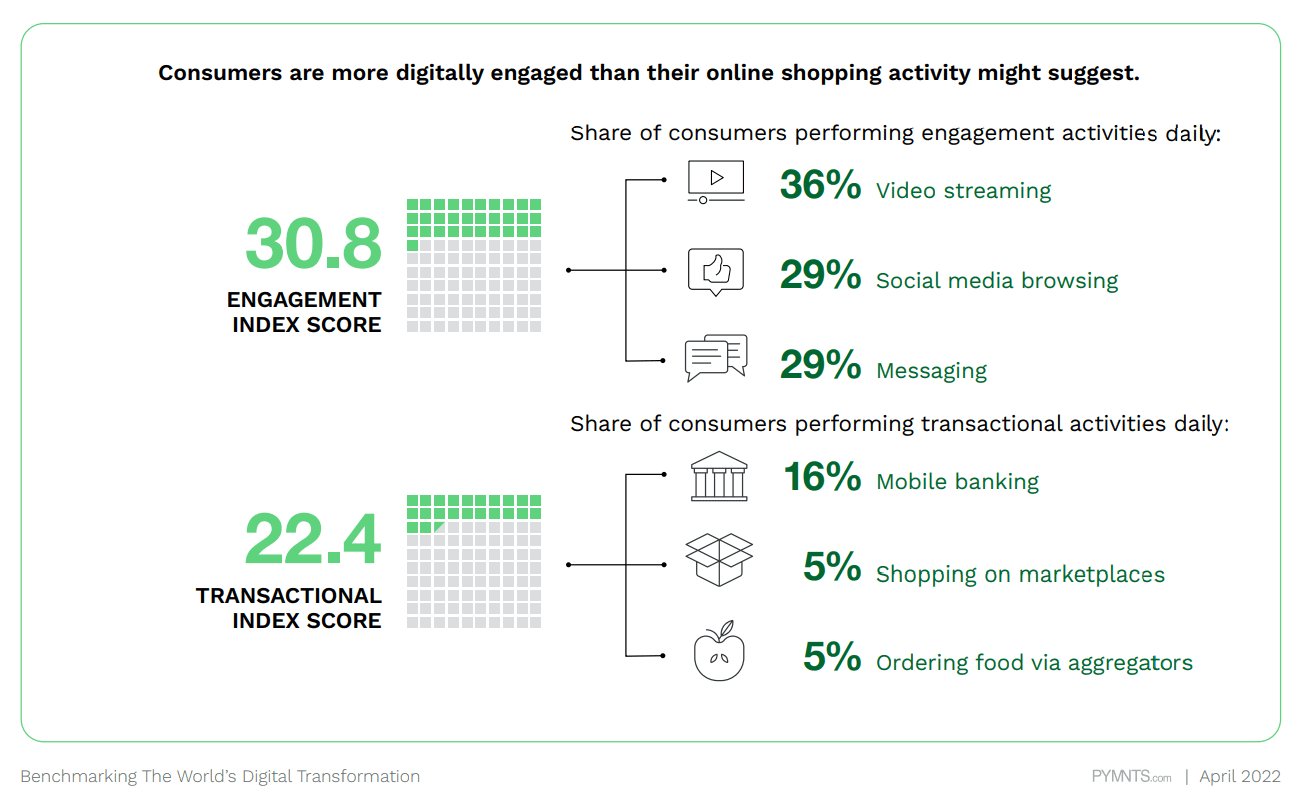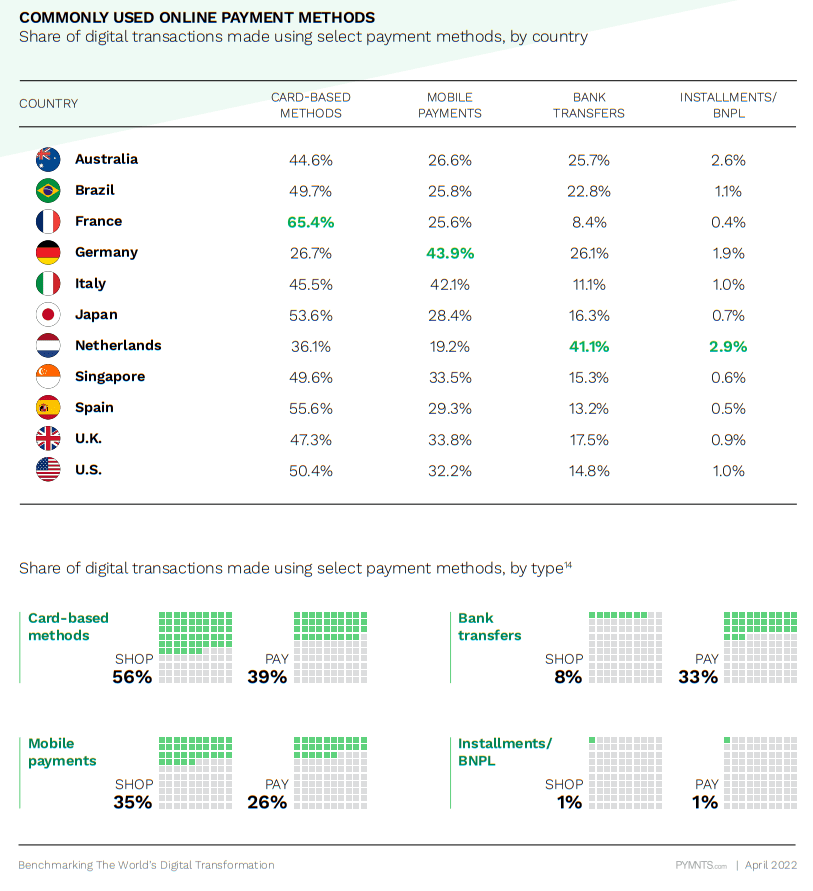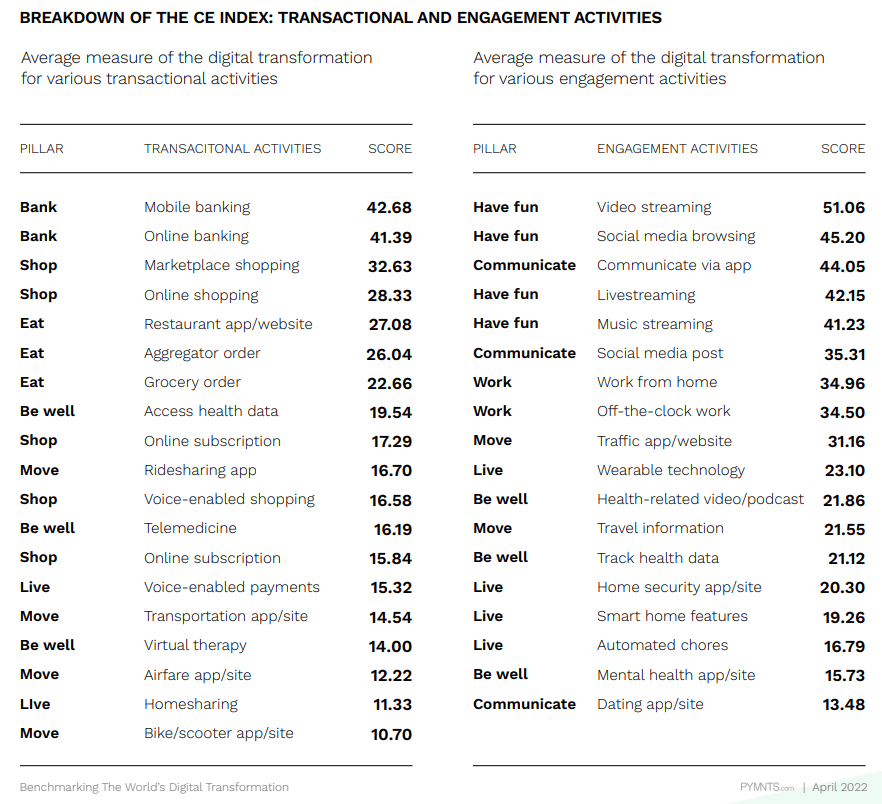New Study: Digital Changing How World Shops, Pays and Banks — At Differing Speeds

We’re mobile and digital and operating in a connected economy that moves at 5G (and in a few years 6G) speeds, yet the digital transformation of global economies is far from complete.
After passing through a frightening time for health and commerce, we find the world nudged along toward a goal of digital connectivity and engagement, which would seem futuristic were it not an absolute reality right now that’s deeply impacting how the world’s consumers shop, pay and bank.
Moving forward, the digital shift set ablaze in 2020 will look quaint in scope and scale as new research shows that despite the ubiquity of smartphones, internet connections and services, most of the world’s developed economies are still in the early phases of transformation.
This march toward comprehensive digital potential is being tracked and quantified quarterly in Benchmarking The World’s Digital Transformation, a PYMNTS and Stripe collaboration measuring consumer engagement in 40 key activities in 10 categories we call “pillars” of the connected economy — touching every part of the way technology is reshaping our lives.
In The ConnectedEconomy™ Index Q1 2022 edition of this series, our findings from surveys of more than 15,100 people in 11 countries concluded that “there’s enormous upside for entrepreneurs, investors and consumers…[as] the digital transformation is only 27% of the way to its full potential across the 11 economies we studied.”
Looking at the just findings in three key areas — how we shop, pay, and bank — gives a sense of the larger opportunities extant and hints at roadblocks yet to overcome on the path toward fuller transformation.

Get it Now: Benchmarking The World’s Digital Transformation – The ConnectedEconomy™ Index Q1 2022
Shopping Should Watch Streaming
With 87% of consumers surveyed connected to the internet, we found that just 19% of them are highly engaged in digital activities like shopping — an unexpectedly low percentage during a waning-but-still-present pandemic.
On the contrary, the study states that “seven times more consumers are engaged daily in watching videos than shopping on a marketplace, and five times more consumers check their social media feeds daily than order food from delivery aggregators. This social context has the potential to become highly transactional as these social platforms monetize the consumer’s attention by payment-enabling those experiences.”
Restaurant and grocery — in a word, food— is one connected activity that draws on others in cascading network effects, as obtaining food touches on at least four of the 10 CE pillars. The research found that 70% of consumers highly engaged digitally in the ‘shop’ pillar (retail shopping) “are also highly digitally engaged in the ‘eat’ pillar (purchasing food from restaurants and grocery stores),” and 64% of those shoppers “also show high digital engagement in grocery purchases, and 75% show high usage of digital methods to buy food from restaurants.”
It’s a clarion call for more focus on social commerce and embedded payments that make the digital engagement a seamless and convenient — and even natural — part of daily routines.
Data Point: Consumers are nearly 40% more engaged, overall, in the channels that are not purpose-built for transacting. This is a major embedded payments opportunity.

Payments Lean Into Digital, But Plastic Prevails
Our research found cards were the most widely used method of payments by consumers across the nations studied, “with 55% of in-store and 49% of digital transactions paid for with network-branded cards, e.g., Visa and Mastercard.”
But markets including Singapore and Germany are pulling ahead with a wider embrace of digital alternatives to credit and debit cards as consumers take greater advantage of how connectedness in finance delivers the truly modern experiences the rest of the world mostly just reads about now.
“Although we find global and domestic cards are the most used payment method for global consumers, online and in the store,” the study noted, “payments preferences vary across the 11 countries studied and include strong preferences for local payments methods, account-to-account transfers, digital wallets, carrier billing and new flows such as installment payments.”
Digital wallets are a key to unlocking the transformational potential, and after languishing somewhat trends like consumers’ growing embrace of touchless/contactless payments are speeding their adoption. Here again, patterns differ based on your geography and your wallet of choice.
“Consumers in different countries use different digital wallets to different extents,” the study found. “PayPal is the most commonly used digital wallet in Germany, where it accounts for 37% of all online transactions. Germany is also the most digital wallet–centric nation, with 44% of all domestic online transactions using digital wallets and 84% using PayPal.”
Data Point: Digital wallets represent 61% of the 51% of all digital transactions that are not made using cards.

Get Your Copy: Benchmarking The World’s Digital Transformation – The ConnectedEconomy™ Index Q1 2022
Bank Pillar Among Top Transformers
Banking ranks closer to high-engagement activities like streaming entertainment and social media than many others, given the central role it plays in relationship to other aspects of connected living — a clear demonstration of how the use of one activity often leads to a network effect.
We found that nearly 6 in 10 (59%) of consumers across all 11 nations engaged in some form of mobile banking, as “the availability of attractive mobile banking alternatives to brick-and-mortar banking — coupled with the widespread availability of smartphones — drives both adoption and usage, and an increase in their overall CE Index ranking” of the ‘bank’ pillar.
The study observes that banking has been on the digital transformation path longer than some other sectors studied, “particularly in developing economies where mobile apps have leapfrogged physical banking options and brought more consumers online for more of their banking and banking-like services.”
Additionally, we concluded that “embedding payments and finance into high engagement experiences is one of the digital economy’s greatest sources of untapped potential.”
Data Point: 33% of all online P2P and bill payments utilize bank transfers, which only account for 8% of all retail payments.

Download now: Benchmarking The World’s Digital Transformation – The ConnectedEconomy™ Index Q1 2022
